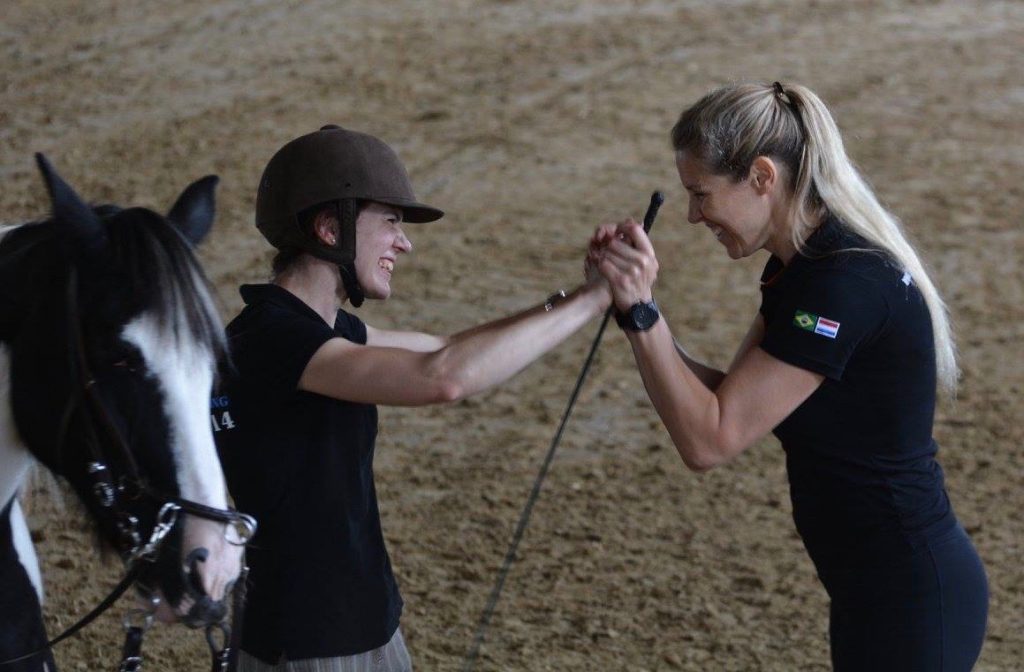Straightness Training is a series of progressive exercises to gently gymnasticize horses in order to improve their balance, suppleness and strength to set them up to carry the added weight of a rider in a sustainable way. It can be used as add-on training for any riding discipline, is suitable for all horse breeds, and can be taught to riders and horses of all skill levels.
After extensive study of the grandmasters of the art of riding, whose teachings form the very foundation of modern dressage, Marijke de Jong of the Netherlands founded Straightness Training with a mission of spreading this classical way of training to riders and horses all over the globe. Her method helps balance horses not just physically, but also mentally, emotionally and spiritually, while greatly improving the bond between horse and rider.
There are five training elements, called “pillars:”
Groundwork
Using a cavesson and a single rein, the horse is taught the basic exercises, followed by the lateral movements in all gaits.
Longeing
Using the cavesson and a longe line, the distance between the horse and trainer is increased, requiring basic balance and increasing self-carriage of the horse.
Work in Hand
In preparation for riding, a curb bit and a pair of reins are added to the cavesson for advanced work from the ground position next to the horse’s shoulder to facilitate control over the outside shoulder.
Riding
While mounted, the basic riding exercises are taught with the cavesson until the horse has learnt all lateral movements and has good basic balance, then a curb bit is added for work on shifting weight onto the hind legs i.e. “collection.”
Liberty
All exercises and lateral movements are also trained at liberty, as this refines and enhances the horse-trainer connection and “brings out the truth” by requiring communication through mostly energetic and mental aids rather than mechanical ones.
Being able to choose an element from the five pillars in each training session means that there is a lot of variety for both trainer and horse, and work on any one of the pillars increases the quality of the others. The horse is well-prepared for carrying the weight of a rider gradually by first learning all lateral movements in groundwork, plus the horse and rider develop a bond of trust long before the horse is actually ridden.
The progressive exercises are built up in six main steps, or “keys,” which are implemented in all five pillars:
Key #1 – Lateral Bend
The horse learns to stretch and contract both sides equally – a first step towards balancing a horse’s natural asymmetry.
Key #2 – Forward Down
The horse learns to stretch forward down to stretch and build up the topline, and to contract its underline.
Key#3 – Stepping Under
The inside hind leg steps towards the point of mass of the horse to increase hind leg flexibility.
These first three keys of Straightness Training are performed simultaneously, as each one improves the other two. We call this LFS, which is short for Lateral bend, Forward down, and Stepping under. The horse is initially taught LFSon a circle at the walk, then on a straight line, and, eventually, at the trot and canter as well.
Key#4 – Bending the Inside Hind Leg i.e. Shoulder-In
This further increases the flexibility of the inside hind leg and frees the outside shoulder. This exercise was first introduced on a straight line by the Grandmaster François Robichon de la Guérinièrein the 18th century, and is often referred to as “the aspirin of riding.”
Key#5 – Bending the Outside Hind Leg i.e. Haunches-in
This exercise engages the outside hind leg as well i.e. brings it towards the point of mass, but without losing the stepping-under of the inside hind leg. Variations of this exercise are renvers, half-pass, and pirouette.
Key#6 – Bending Both Hind Legs e.g. Piaffe, Passage, Levade
In these high-level exercises, the horse bends both hind legs, carrying up to 100% of the horse’s weight in the levade.
Because the primary focus of Straightness Training is to develop a symmetrical, balanced, and willing partner without resorting to force, every horse and rider, regardless of discipline, can benefit from this unique training. Likewise, horses’ physical, behavioral, and mental issues can often be resolved through Straightness Training as well.
To find out more, please visit www.straightnesstraining.com

